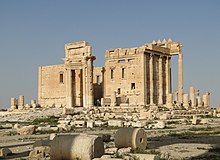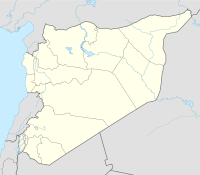Temple of Bel
معبد بل | |
 The Temple of Bel in 2010 | |
| Location | Palmyra, Syria |
|---|---|
| Type | Temple |
| Height | 15 metres (49 ft) |
| History | |
| Material | Stone |
| Founded | 32 AD |
| Cultures | Palmyrene |
| Site notes | |
| Condition | Largely destroyed, some remains survive |
| Ownership | Public |
| Public access | Inaccessible (in a war zone) |
| Type | Cultural |
| Criteria | i, ii, iv |
| Designated | 1980 (4th session) |
| Part of | Site of Palmyra |
| Reference no. | 23 |
| State Party | Syria |
| Region | Arab States |
| Endangered | 2013–present |
The Temple of Bel (Template:Lang-ar), also known as the Temple of Baal, was an ancient temple located in Palmyra, Syria. The temple, consecrated to the Mesopotamian god Bel, worshipped at Palmyra in triad with the lunar god Aglibol and the sun god Yarhibol, formed the center of religious life in Palmyra and was dedicated in 32 AD.[1][2] Its ruins were considered among the best preserved at Palmyra,[3] until they were further destroyed by the Islamic State of Iraq and Syria in August 2015.[4] The arched main entrance into the temple is still intact.
History
The temple was built on a tell with stratification indicating human occupation that goes back to the third millennium BC. The area was occupied in pre-Roman periods with a former temple that is usually referred to as "the first temple of Bel" and "the Hellenistic temple". The walls of the temenos and propylaea were constructed in the late first and the first half of the second century AD. The names of three Greeks who worked on the construction of the temple of Bel are known through inscriptions, including a probably Greek architect named Alexandras (Template:Lang-gr).[5][6] However, many Palmyrenes adopted Greco-Roman names and native citizens with the name Alexander are attested in the city.[7]
The Temple of Bel was converted into a Christian church during the Byzantine Era.[8] Parts of the structure were modified by Arabs in 1132 which preserved the structure and converted the Temple into a mosque. It remained in use as a mosque until the 1920s.[9] Most of the Corinthian columns of the inner colonnades still showed pedestals where the statues of the benefactors stood.[2] The temple was aligned along the eastern end of the Great Colonnade at Palmyra.
Architecture


The temple showed a remarkable synthesis of ancient Near Eastern and Greco-Roman architecture.[1] The temple remains lay inside a large precinct lined by porticos. It had a rectangular shape and was oriented north-south.[1] It was based on a paved court surrounded by a massive 205-metre (673 ft) long wall with a propylaeum. On a podium in the middle of the court was the actual temple building. The cella was entirely surrounded by a prostyle of Corinthian columns, only interrupted on the long side by an entrance gate with large steps leading from the court. The cella was unique in the fact that it had two inner sanctuaries, the north and south adytons, dedicated as the shrines of Bel and other local deities. The northern chamber was known for a bas-relief carving of the seven planets known to the ancients surrounded by the twelve signs of the Zodiac and the carvings of a procession of camels and veiled women.[10] The cella was lit by two pairs of windows cut high in the two long walls.[1][2] In three corners of the building stairwells could be found that led up to rooftop terraces.[1]
In the court there were the remains of a basin, an altar, a dining hall, and a building with niches. And in the northwest corner lay a ramp along which sacrificial animals were led into the temple area.[2] There were three monumental gateways, of which the entry was through the west gate. These were modified by the Arabs in 1132 when they erected a bastion, and the temple was converted into a mosque,[10] which preserved it from further dilapidation.
Destruction

Syria's Director of Antiquities Maamoun Abdul Karim stated that ISIL were looking for treasures and "stores of gold" in the city.[11] On 30 August 2015, the Associated Press reported that the Islamic State of Iraq and the Levant had partially demolished the temple by explosives, citing eyewitness accounts.[12][13] The bricks and columns were reported as lying on the ground and only one wall was reported as remaining, according to a Palmyra resident.[14][15] The damage was also attested by the Syrian Observatory for Human Rights.[16] Syria's antiquities chief Maamoun Abdulkarim later stated that although there was an explosion within the temple's perimeter, "the basic structure is still standing".[17] However, these reports were proved to be incorrect.
On August 31, 2015 the United Nations confirmed the temple's destruction after reviewing satellite imagery, "We can confirm destruction of the main building of the Temple of Bel as well as a row of columns in its immediate vicinity" reported by the United Nations Institute for Training and Research (UNITAR).[18][4] The BBC issued a video report showing the satellite images and the destruction described by Einar Bjorgo, manager of UN Satellite Imaging (UNOSAT UNITAR).[19]
The main entrance arch survived the destruction of the temple. The Institute for Digital Archaeology proposed that replicas of this arch be installed in Trafalgar Square, London and Times Square, New York City.[20] It was later decided that instead of the temple's main entrance, the replica would be of part of the Monumental Arch.[21]
Following the recapture of Palmyra by the Syrian Army in March 2016, director of antiquities Maamoun Abdelkarim stated that the Temple of Bel, along with the Temple of Baalshamin and the Monumental Arch, will be rebuilt using the surviving remains (anastylosis).[22]
References
- ^ a b c d e Gates, 2003, p.390–91.
- ^ a b c d Kaizer, p.67.
- ^ Cremin, p.187.
- ^ a b "Palmyra's Temple of Bel destroyed, says UN". BBC News. 1 September 2015. Retrieved 10 September 2015.
- ^ Stoneman, Richard (1994). Palmyra and Its Empire: Zenobia's Revolt Against Rome. Ann Arbor, MI: University of Michigan Press. p. 54. ISBN 9780472083152.
- ^ Alcock, Susan E. (1997). The Early Roman Empire in the East. Ann Arbor, MI: University of Michigan Press. p. 157. ISBN 9781900188524.
- ^ Yon, Jean-Baptiste (2002). Les notables de Palmyre. Institut français d'archéologie du Proche-Orient. pp. 10, 59. ISBN 9782912738196.
- ^ Browning, Iain (1979). Palmyra. Noyes Press. p. 168. ISBN 9780815550549.
Like the Temple of Bel, the Baal Shamin was converted into a church during the Byzantine period.
- ^ Yan, Holly (1 September 2015). "How ISIS' demolition of a Syrian temple impacts the world". CNN. Retrieved 1 February 2016.
- ^ a b "Temple of Bel". Syrian Embassy in the United States. Archived from the original on 15 July 2009. Retrieved 31 August 2015.
- ^ "Syrian archaeologist 'killed in Palmyra' by IS militants". BBC News. 19 August 2015. Retrieved 10 September 2015.
- ^ Westall, Sylvia (30 August 2015). "Islamic State destroys part of Syria's Temple of Bel – monitors". Reuters UK.
- ^ "СМИ: боевики ИГ подорвали Храм Бэла на территории сирийской Пальмиры". RIA Novosti (in Russian). 30 August 2015. Retrieved 10 September 2015.
- ^ "Syria's Palmyra Temple of Bel 'severely damaged' by IS". BBC News. 31 Aug 2015. Retrieved 10 September 2015.
- ^ "IS Partially Destroys Temple Of Bel – Reports". Sky News. 31 August 2015. Retrieved 10 September 2015.
- ^ "Activists: ISIL damages ancient temple in Syria's Palmyra". USA Today. Associated Press. 30 August 2015. Retrieved 10 September 2015.
- ^ "Palmyra's Temple of Bel 'still standing'". BBC News. 31 August 2015. Retrieved 10 September 2015.
- ^ Barnard, Anne; Saad, Hwaida (2015-08-31). "Palmyra Temple Was Destroyed by ISIS, U.N. Confirms". The New York Times. ISSN 0362-4331. Retrieved 2015-09-01.
- ^ "Satellite images show Palmyra temple destruction". BBC News. 1 September 2015. Retrieved 10 September 2015.
- ^ Gayle, Damien (28 December 2015). "Palmyra arch that survived Isis to be replicated in London and New York". The Guardian. Archived from the original on 9 January 2016.
- ^ Richardson, Nigel (8 April 2016). "Why the Arch of Triumph of Palmyra is being recreated in London - 1,800 years after it was built". The Telegraph. Retrieved 8 April 2016.
- ^ Shaheen, Kareem; Graham-Harrison, Emma (27 March 2016). "Syrian regime forces retake 'all of Palmyra' from Isis". The Guardian. Archived from the original on 27 March 2016.
Bibliography
- Becker, Jeffrey A. Temple of Bel. Smarthistory
- Gates, Charkes (2003), Ancient cities: the archaeology of urban life in the Ancient Near East and Egypt, Greece and Rome, Routledge, ISBN 978-0-415-01895-1
- Kaizer, Ted (2002), The religious life of Palmyra: a study of the social patterns of worship in the Roman period, Franz Steiner Verlag, ISBN 978-3-515-08027-9
- Cremin, Aedeen (2007), Archaeologica: The World's Most Significant Sites and Cultural Treasures, Frances Lincoln Ltd., ISBN 978-0-7112-2822-1
External links
- 1st-century Roman temples
- 32 in Asia
- Ancient Roman buildings and structures in Syria
- Ancient Roman temples
- Buildings and structures in Palmyra
- Former places of worship in Syria
- Conversion of non-Christian places of worship into churches
- Conversion of non-Muslim places of worship into mosques
- Buildings and structures destroyed by ISIL
- Buildings and structures demolished in 2015
- Destroyed temples
- Archaeological sites in Syria

